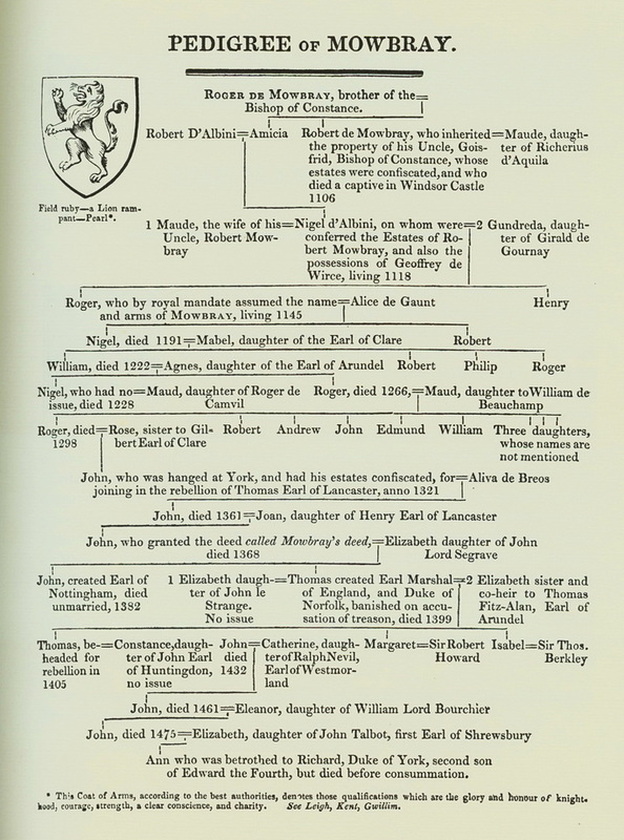The Mowbray Family

The Mowbray Family Crest
The chief tenants of the Saxon lord at the time of the conquest were; Ledwin at Epworth, Ulf, Alnod, Colgrim & Ulfenisc at Belton, Siward Barn & Wazelin at Haxey, Fulcheri & Weghe at Lound, Guede at Owston and Fulcheri & Ulfenisc at Crowle. After the conquest the king divided the country amongst his supporters, the Isle of Axholme, along with other lands were given to Geoffrey de Wirce (who had fought alongside William the Conqueror and continued to be the Kings advisor). After his death around 1088 his estates reverted to the Crown and were then passed to his nephew Robert de Mowbray Earl of Northumberland. The family name derives from Montbrai in Manche, Normandy, Mowbray being a corruption of it. Robert was imprisoned for treason in 1096 after a failed revolt against William II and his lands were given, in 1101, by King Henry I to Nigel de Albini (d'Aubigny), Mowbray's cousin and one of the Kings favoured supporters, de Albini subsequently married Mowbray's former wife Matilda, they divorced in 1118 and he married Gundred de Gournay They had a son, Roger who inherited the estates originally forfeited by Robert Mowbray. On receiving his inheritance Roger changed his name to Mowbray at the instruction of Henry I. The Mowbray family were to remain Lords of the Manor of Epworth & Westwood until the death of the last male descendant, John de Mowbray sixteenth baron who died in 1476.
The Mowbray’s had a mansion which was sited somewhere near St Andrews church, Epworth, on land called the Vine - Garths, the meaning of this is not clear, it could obviously refer to the growing of vines, or it could be a corruption of the Danish, yang, meaning the closed land, as opposed to the open field. Some of the buildings were still standing in the 1770’s but there was nothing left by the 1800’s, excavation was undertaken in the 1970’s, with a few finds resulting. The Mowbray family who were extremely wealthy and powerful, made Epworth the centre of its activities, even though they had extensive estates in Leicestershire, Lincolnshire and Yorkshire. Roger de Mowbray died at the mansion in 1266, John de Mowbray, who gave the deed to the commoners, to enable ownership of the land, had a son born there in 1326, and a grandson in 1365, In 1340 it was the summer residence of Katharine Duchess of Norfolk, as there is evidence of a letter written by her, dated 1st of October and written in “Eppeworth”.
Sometime after the death of the sixteenth baron, the manors began to be split up, due to the last surviving heir, Ann de Mowbray, who was married to Richard Duke of York, dying without the marriage being consummated. The inheritance of the family passed into the Howard and Berkley families. In the reign of Henry VIII, the manor, together with other property in the Isle, was disposed of by William Marquis of Berkley, to Thomas Stanley Earl of Derby. By exchange, it became the property of the crown, in the reign of Elizabeth I, a small portion consisting of the Ferry and Ferry house, called Kinnard Ferry, (Owston Ferry), with certain portions of lands in the “Belgraves” were sold by James I to a goldsmith in London to a for £100 .The remainder formed part of the marriage jointure of Charles I wife.
The Mowbray’s had a mansion which was sited somewhere near St Andrews church, Epworth, on land called the Vine - Garths, the meaning of this is not clear, it could obviously refer to the growing of vines, or it could be a corruption of the Danish, yang, meaning the closed land, as opposed to the open field. Some of the buildings were still standing in the 1770’s but there was nothing left by the 1800’s, excavation was undertaken in the 1970’s, with a few finds resulting. The Mowbray family who were extremely wealthy and powerful, made Epworth the centre of its activities, even though they had extensive estates in Leicestershire, Lincolnshire and Yorkshire. Roger de Mowbray died at the mansion in 1266, John de Mowbray, who gave the deed to the commoners, to enable ownership of the land, had a son born there in 1326, and a grandson in 1365, In 1340 it was the summer residence of Katharine Duchess of Norfolk, as there is evidence of a letter written by her, dated 1st of October and written in “Eppeworth”.
Sometime after the death of the sixteenth baron, the manors began to be split up, due to the last surviving heir, Ann de Mowbray, who was married to Richard Duke of York, dying without the marriage being consummated. The inheritance of the family passed into the Howard and Berkley families. In the reign of Henry VIII, the manor, together with other property in the Isle, was disposed of by William Marquis of Berkley, to Thomas Stanley Earl of Derby. By exchange, it became the property of the crown, in the reign of Elizabeth I, a small portion consisting of the Ferry and Ferry house, called Kinnard Ferry, (Owston Ferry), with certain portions of lands in the “Belgraves” were sold by James I to a goldsmith in London to a for £100 .The remainder formed part of the marriage jointure of Charles I wife.



